Appcues vs Usetiful vs Userpilot: Which is Best for Your SaaS?
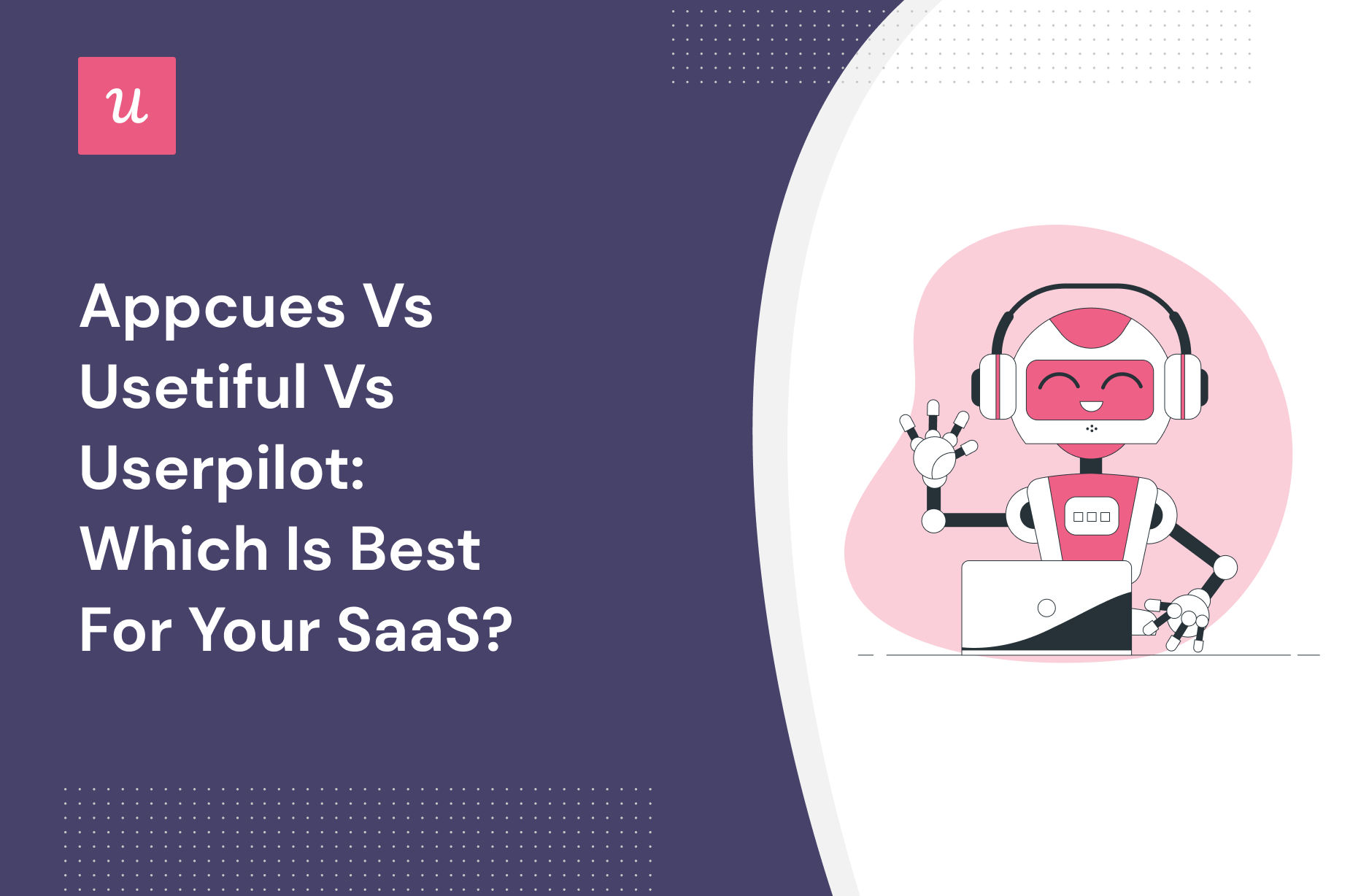
Selecting the optimal product adoption platform for your SaaS can be a challenging task. To assist you in making an informed decision, we have prepared a comprehensive analysis of three tools – Appcues, Usetiful, and Userpilot – which delves deeper into their functionalities, use cases, advantages, and disadvantages than what is typically available on review sites.
Whether your primary objective is to improve your user onboarding or product analytics, gather user feedback, or NPS, you will obtain a detailed comparison of Appcues, Usetiful, and Userpilot to determine which one suits your requirements best.
So let’s delve into the details!
TL;DR
- Appcues is another no-code user onboarding platform that helps non-technical teams track and analyze product usage. You can publish in-app onboarding tours, announcements, and launch surveys. Unlike Userpilot, the functionality is limited if you are using the basic plans.
- Usetiful is a cloud-based digital adoption platform focused on both employee and user onboarding that offers advanced onboarding features such as interactive guided tours, checklists, and smart hints that encourage users to engage with the product and drive them toward adoption.
- Userpilot is a comprehensive digital adoption platform (DAP). It enables product teams to track product usage and user behavior to guide product development and optimize the user experience. In addition, it allows them to gather user feedback and design personalized onboarding experiences to drive product adoption. All of this is possible without coding. Book a demo to learn more!
![]()
Comparing Appcues vs Usetiful vs Userpilot? Try the best one now!

What is Appcues?
Appcues is another no-code user onboarding platform that helps non-technical teams track and analyze product usage. You can publish in-app onboarding tours, announcements, and launch surveys.
Unlike Userpilot, the functionality is limited if you are using the basic plans.
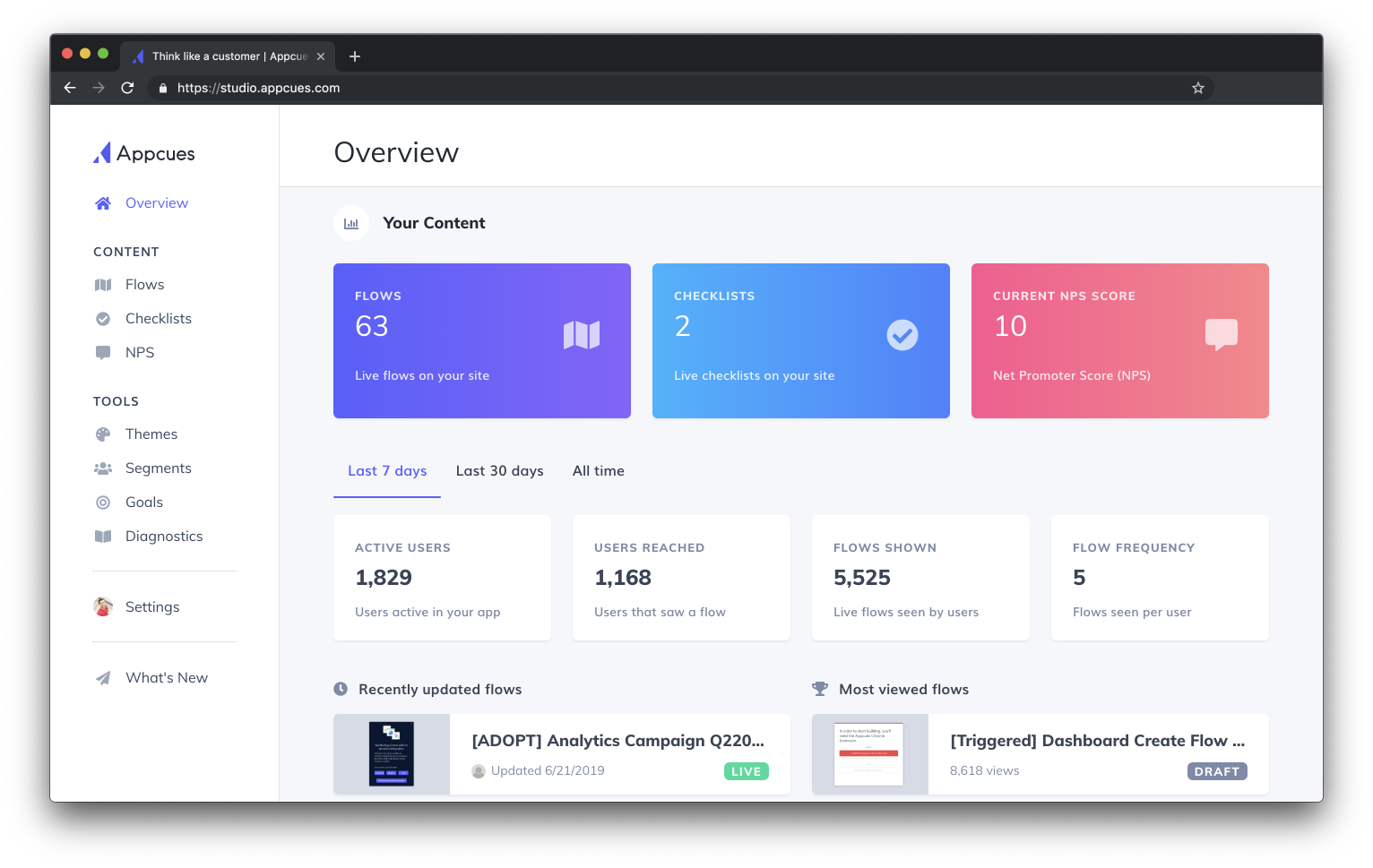
What is Appcues best for?
Typically, SaaS Product Managers consider Appcues for the following reasons: they want to improve their user onboarding, they need product adoption, and would also be able to measure their user feedback. How does Appcues perform when it comes to these top-three use cases? Let’s examine it all, and then compare it to the other tools we’re discussing in this post.
Appcues for user onboarding
Appcues used to provide onboarding templates, which made it easy to use the tool. However, it provided a predefined way of thinking about onboarding all while having a higher price tag than other onboarding software. As of the time of writing (end of 2022), Appcues has removed its onboarding templates – without really replacing them with another solution.
Appcues allows you to design flows that make onboarding processes a breeze. These flows are what you use to create product tours and other in-app communication with users.
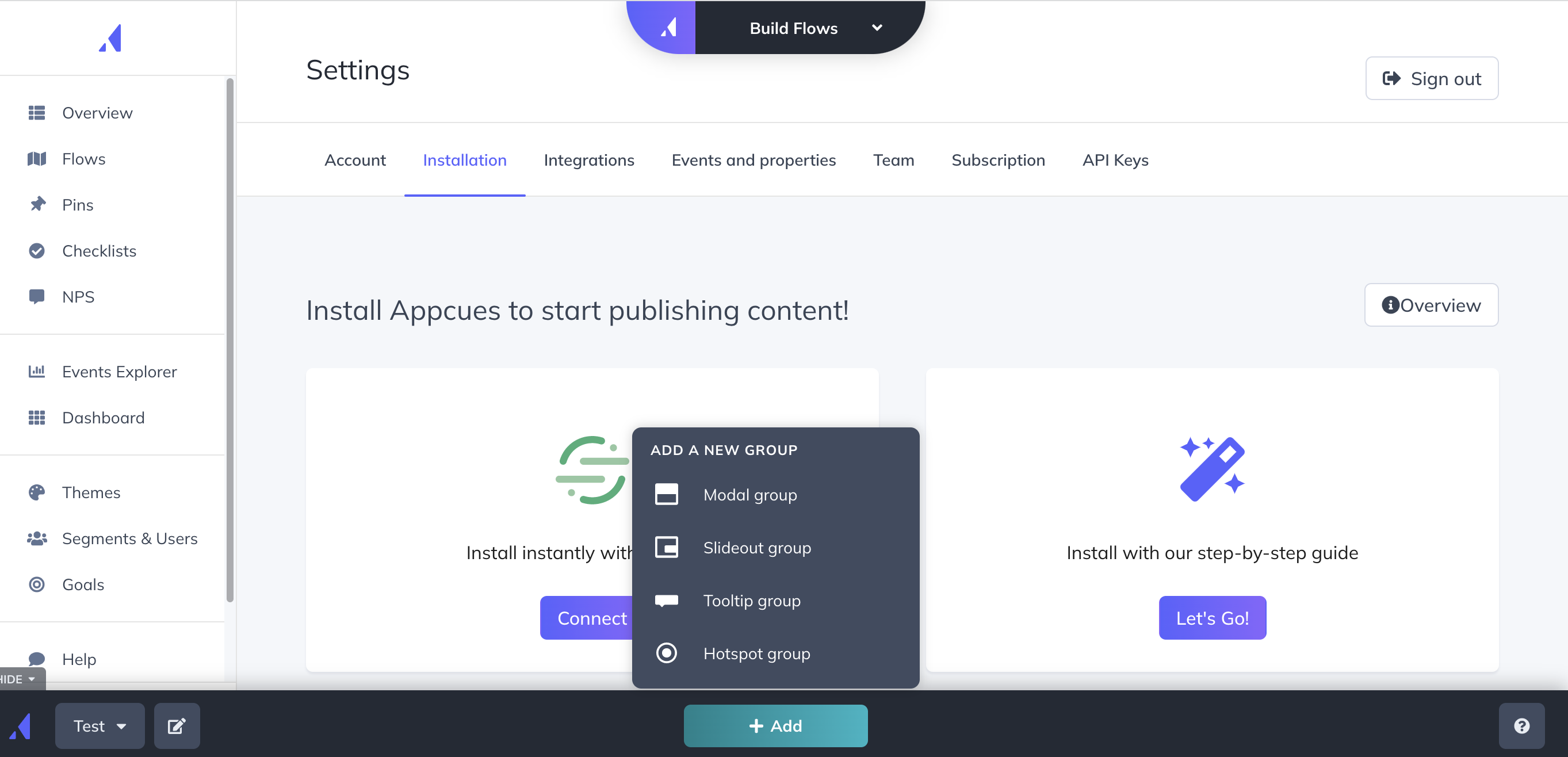
Appcues for user onboarding.
Here’s what you’ll get when you start using Appcues:
- Access to an easy-to-use UI that anyone on the team can handle for building in-app flows without coding.
- Building a product tour in Appcues is relatively easy. You just need to open their Chrome extension on top of your application and start building your in-app experiences with a WYSIWYG editor. You simply select a UI pattern and customize it ‘live’, or point to the elements you want to e.g. append your tooltips to.
- Previously it was even easier – you chose one of its templates, they would basically create the product tour for you, and you just needed to customize each step. This limited the options for customizing but it was useful for beginners. We don’t know if Appcues plans to bring their templates back.
- You can also create checklists with Appcues (NOT available on the Essentials plan) and prompt users to take action. These are ok but have limited functionality (can’t trigger JS functions, or add gamification elements) compared to alternatives, such as Userpilot.
- Track UI engagement with Events Explorer which allows you to tag elements without coding.
- Build custom user segments (up to 5 on the Essentials plan) based on user properties, flows, interactions, or events you set up in the events explorer.
Appcues for product adoption
When it comes to driving product adoption, Appcues offers the main functionality as its competitors but highly restricts it when using its lower plan. This makes it quite pricey if you need checklists for example, which are quite an essential tool for getting users to engage and adopt your product.
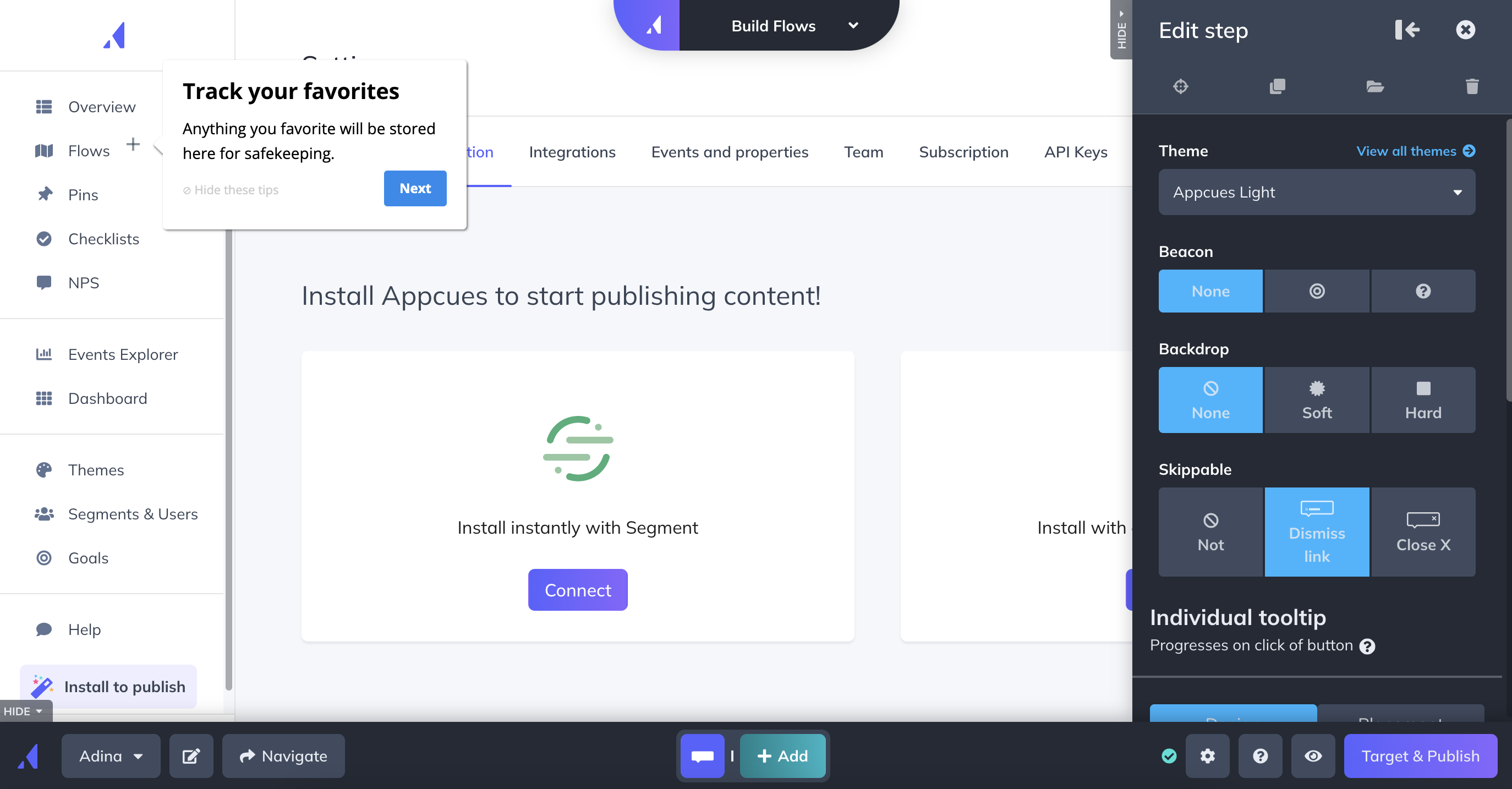
Appcues for product adoption.
Here’s how Appcues can help drive adoption:
- Building a product tour in Appcues is relatively easy. You can choose from a range of UI patterns and use a friendly Chrome extension builder. If you want to style the modals or tooltips in your tour to match your native UI, you might need to resort to CSS.
- Welcome screens are an integral part of Appcues product tour templates. You can mostly customize them as you please by adding or removing elements, micro surveys, etc.
- The flows option offers 4 main onboarding elements (modal group, tooltip group, slideout group, and hotspot group) and only 1 action – navigating to a different page.
- You can get access to building checklists but only on the more expensive plans.
- Unlike its alternatives, Appcues doesn’t offer the possibility of building an in-app resource center.
Appcues for user feedback
Can you use Appcues to collect user feedback? Of course.
Collecting data is not hard, analyzing and acting on it is where it gets tricky. What’s the purpose of having data if you can’t act on it?
If you want to track your NPS score over time and collect user feedback with short micro surveys, you can do that with Appcues. But to analyze the feedback data in-depth, you’ll have to use other tools.
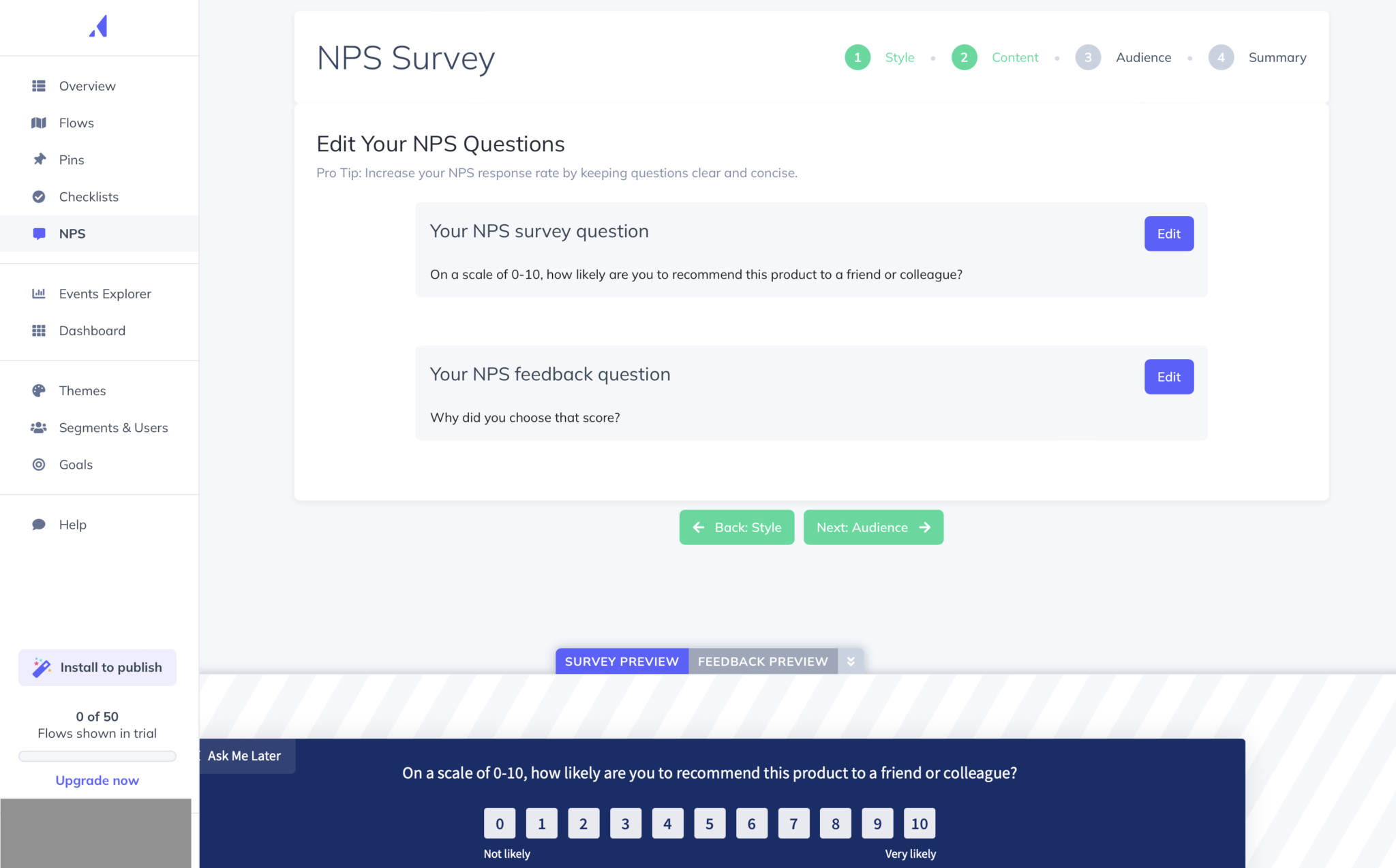
Appcues for user feedback.
In a nutshell, Appcues allows you to:
- Build and trigger NPS surveys in-app without coding.
- Edit the NPS survey questions.
- Target the survey at a specific user segment (or choose one of the predefined segments) and adjust the survey display frequency.
- Collect user feedback with short surveys built on top of modals: add numerical scale, open-ended questions, or radio button questions.
- On the flip side: you can’t tag your NPS/survey responses in-app and use these tags to segment your audience by them.
- You can’t analyze the responses in-app. You can only download a CSV report to start analyzing your data – and we all know how time-consuming that is.
Based on the above, when it comes to user feedback, Appcues is not the ideal tool, as it lacks the ability to segment users based on survey responses.
![]()
There is a better tool for your SaaS than Appcues! Try Userpilot today!

What is Usetiful?
Usetiful is a cloud-based digital adoption platform focused on both employee and user onboarding.
The tool offers advanced onboarding features such as interactive guided tours, checklists, and smart hints that encourage users to engage with the product and drive them toward adoption.
Usertiful is especially praised by its customers for having a simplistic, user-friendly design and a helpful customer support team.
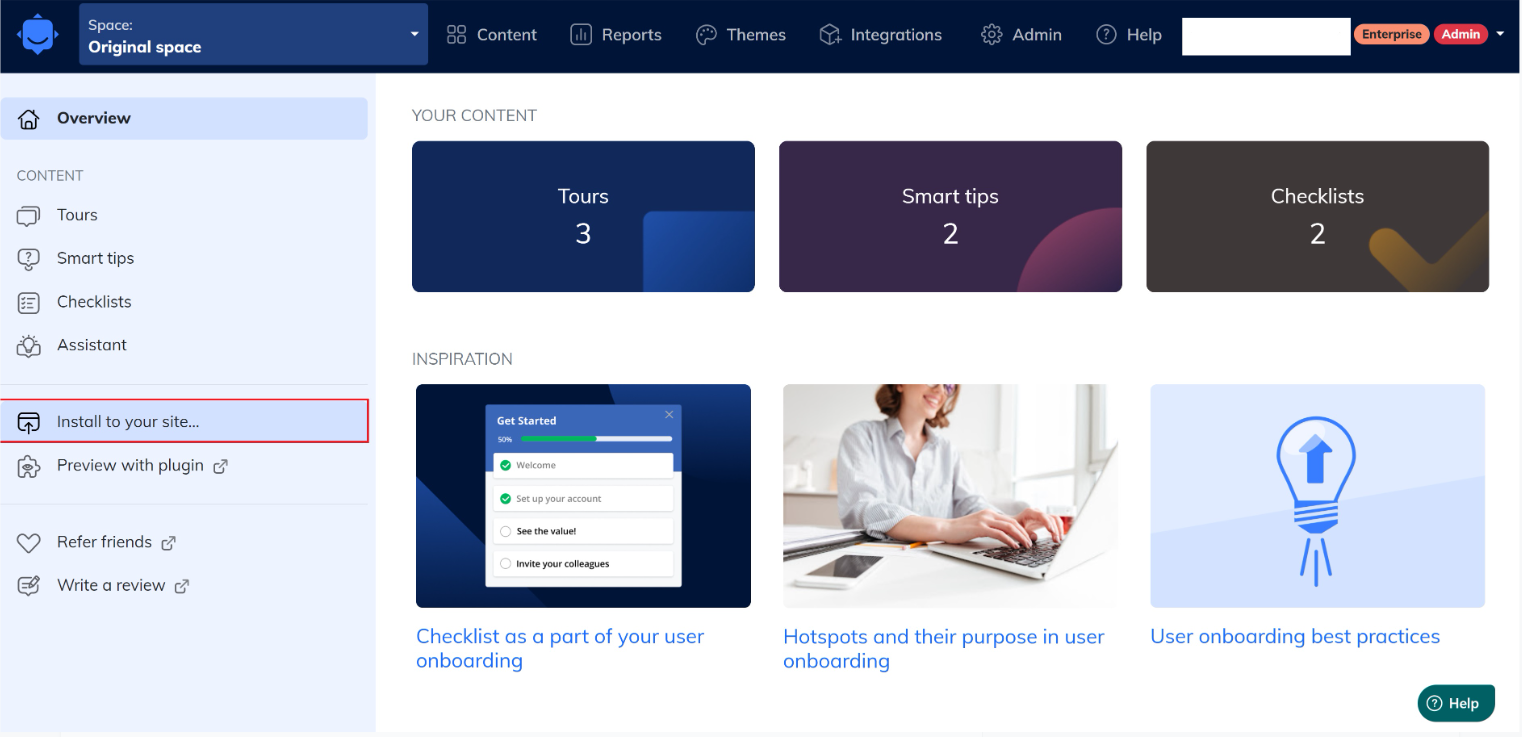
What is Usetiful best for?
Similar to Appcues, Usetiful is typically considered for user onboarding, product adoption, and user feedback. Let’s examine Usetiful for these use cases before we compare it to Userpilot.
Usetiful for user onboarding
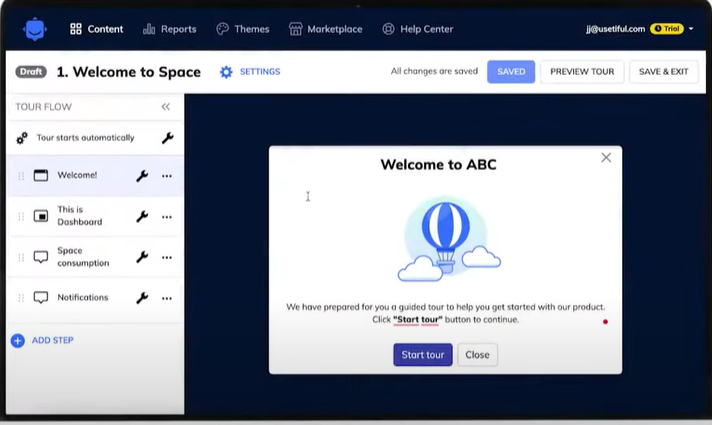
Usetiful for user onboarding.
Here’s how Usetiful can help with user onboarding:
- Create onboarding checklists that drive users toward key actions and accelerate activation.
- Design interactive product tours that embrace the learn-by-doing approach and teach how to use a feature step-by-step. You can incorporate different UI elements into walkthroughs such as tip balloons, pointers, modals, and slideouts. Either customize the available templates or use the WYSIWYG (what-you-see-is-what-you-get) visual design studio editor for creating original designs from scratch.
- Segment customers based on attributes like role, language, status, etc, and target them with tailored onboarding experiences that deliver the promised value fast.
- Provide in-app guidance using Smart Tips. Those are similar to tooltips in their anatomy but unlike tooltips, which mainly highlight relevant features and engage users with them, Smart Tips are more geared towards reducing friction and preventing user errors. For instance, you can add Smart Tips to forms and provide additional instructions on how to successfully fill them out.
Usetiful for product adoption
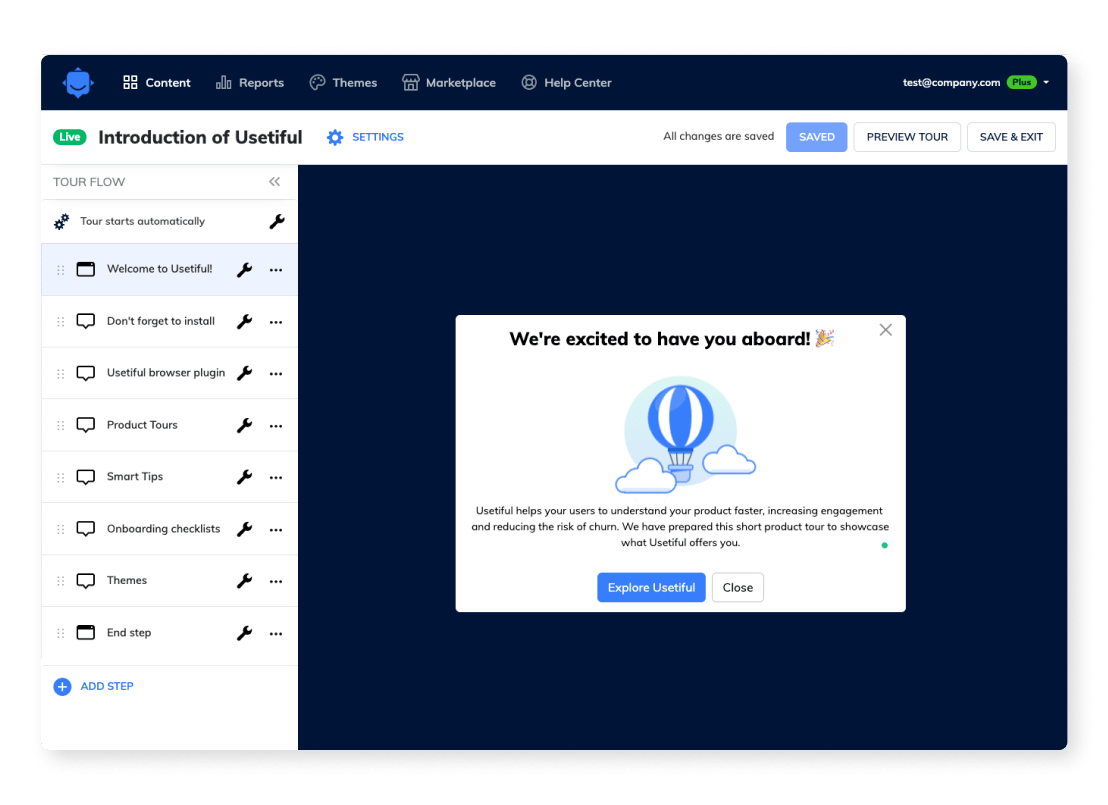
Usetiful for product adoption.
Usetiful describes itself as a tool aiming to bridge the gap between users and digital systems, so it’s no surprise that it comes with powerful product adoption features. Here’s how Usetiful functionalities can help you drive adoption:
- Create onboarding checklists that list the most important steps users must take in order to experience value. You can even gamify the checklists and add progress bars to motivate users to complete them.
- Design interactive guides that teach customers how to use a feature step-by-step. You can either use a friendly Chrome extension or a visual editor inside Usetiful to build those tours effortlessly.
- Reduce adoption friction with in-app messages called Smart Tips. Those are advanced tooltips that prevent user errors and smoothen the adoption experience by providing additional information and guidance wherever the user needs it.
If you are a small startup looking to build simple in-app flows and experiences, Usetiful is a great fit. However, if your product is complex and you want to create more sophisticated and customized flows, this might not be for you.
Usetiful for user feedback
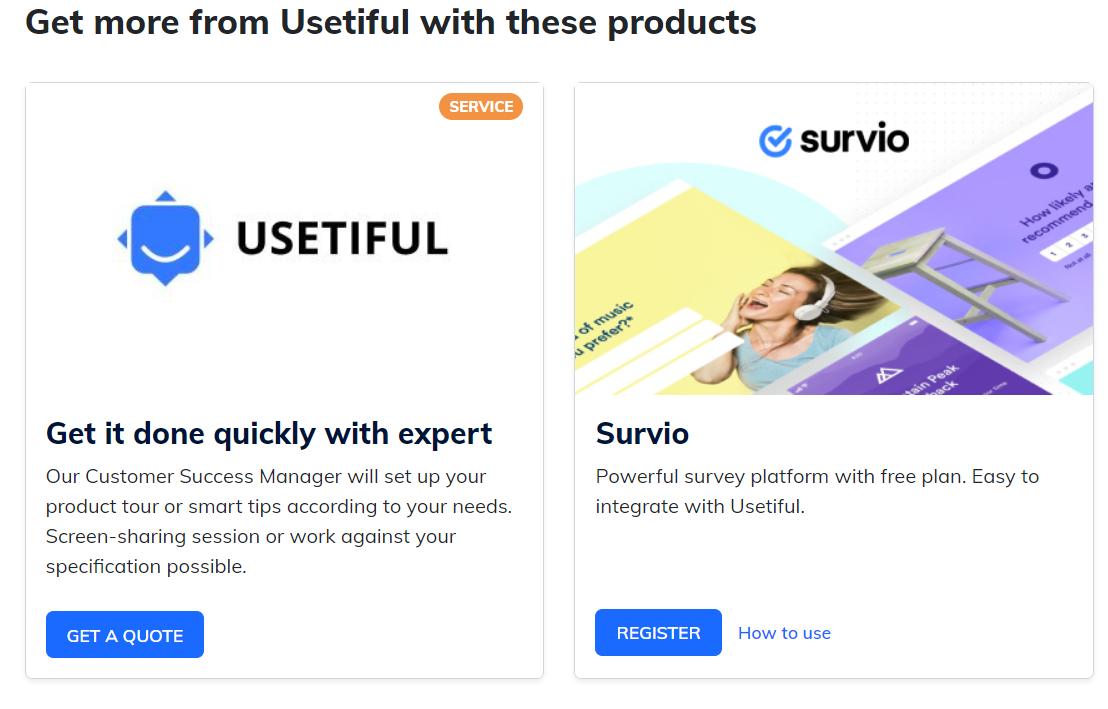
Usetiful for user feedback.
Usetiful doesn’t support native in-app surveys, but its integration with Survio makes in-product feedback collection possible. You have to register and create a survey in Survio, then copy the code and past it into Usetiful’s flow builder. Then you can:
- Trigger survey flows to specific user segments.
- Collect feedback on product tours and continuously improve them.
Based on the above, when it comes to user feedback, Usetiful isn’t a great tool, as it lacks the ability to create surveys directly within the app and segment users based on survey responses to deliver tailored experiences.
![]()
Try a better tool for your SaaS than Usetiful!

What is Userpilot?

Userpilot is a comprehensive digital adoption platform (DAP). It enables product teams to track product usage and user behavior to guide product development and optimize the user experience.
In addition, it allows them to gather user feedback and design personalized onboarding experiences to drive product adoption. All of this is possible without coding.
What is Userpilot best for?
Userpilot is used for similar use cases as Usetiful and Appcues. Let’s see how Userpilot compares to the tools we discussed before it comes to user onboarding, product adoption, and user feedback.
Userpilot for user onboarding
Userpilot was built specifically for SaaS product teams that want to improve their user onboarding experience and boost user activation.
You can build a huge variety of user onboarding experiences and in-app guidance flows without needing to code.
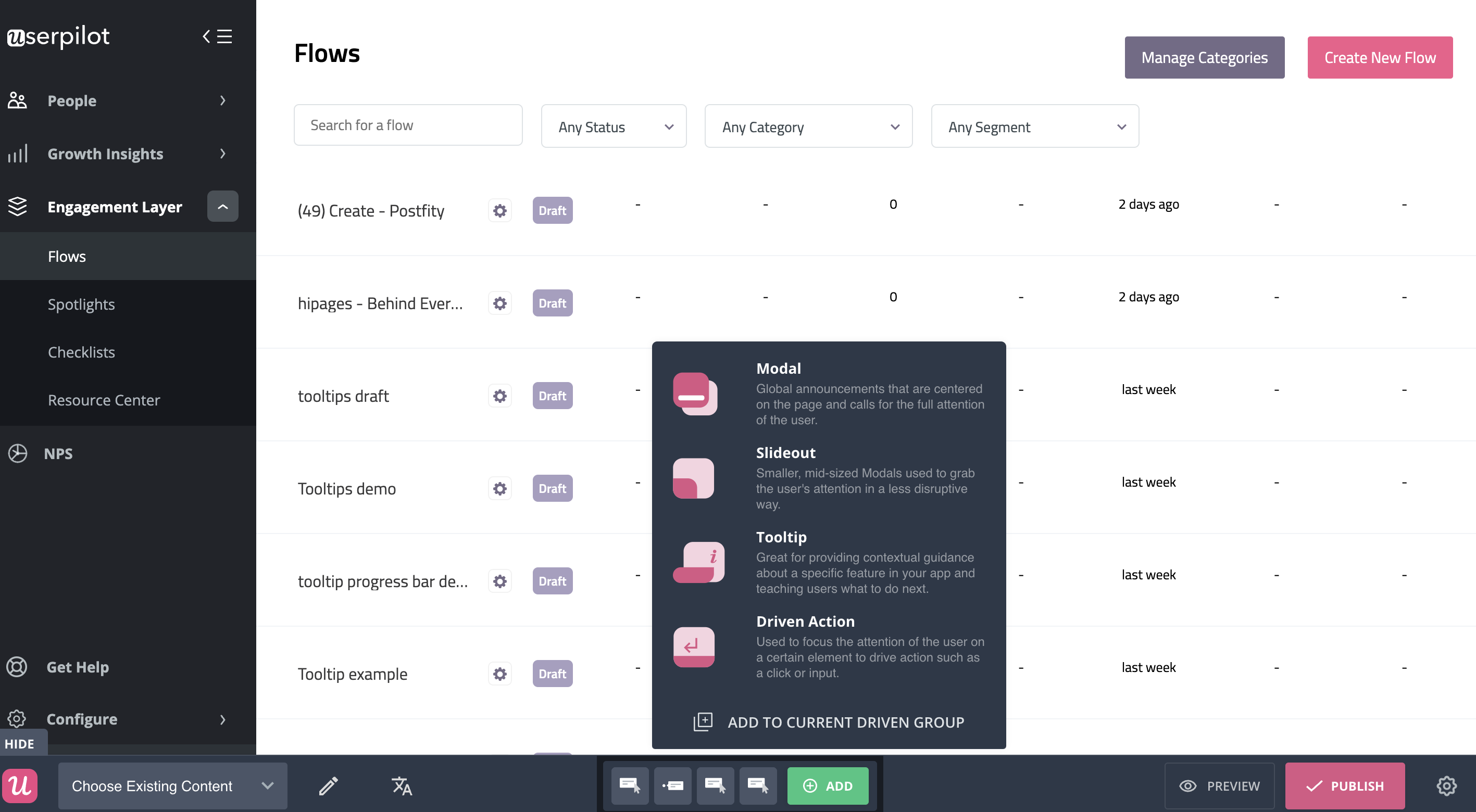
Userpilot for user onboarding.
Here’s what you’ll get when you start using Userpilot:
- Forget about coding in-app experiences: Userpilot is a no-code solution and only requires your dev to install a line of javascript inside your app and for you to download a Chrome extension that opens up the visual builder.
- Build in-app flows using the largest range of UI patterns (modals, slideouts, tooltips, hotspots, banners) and in-app onboarding experiences (checklists, micro surveys, NPS surveys, in-app resource center).
- Get access to a built-in NPS tool for collecting and analyzing user sentiment so you can improve your onboarding process based on real data.
- Create and track combinations of in-app events like clicks, hovers, and form fills, and then analyze all these interactions under your own custom events, which can be built without code or API calls.
- Use advanced product analytics and in-app flows analytics to identify where users need help and create granular user segments to trigger in-app experiences contextually (segment based on user identification data, in-app engagement, custom events, clicks, hovers, form fills, user feedback responses, NPS scores and more).
- Enhance the onboarding experience with in-app help by launching a Resource Center directly inside your app. Add in-app guides, and video tutorials, and give users access to search the knowledge base or reach out to support. Self-service has never been easier.
The best user onboarding is contextual and it happens right where the users need it, inside your app. There isn’t a better user onboarding tool out there that offers more value for the money than Userpilot.
Schedule a demo with our team and get ready to build the best onboarding experiences your users have seen.
Userpilot for product adoption
Product adoption describes the process of getting users to the point where they are experiencing value from your product.
Userpilot is a powerful product adoption platform that enables you to quickly build personalized and contextual in-app experiences targeted to different user experiences – all without writing a line of code.
It’s a great option for enterprise users too since it’s SOC 2 Type II certified and offers robust features for large-scale usage.
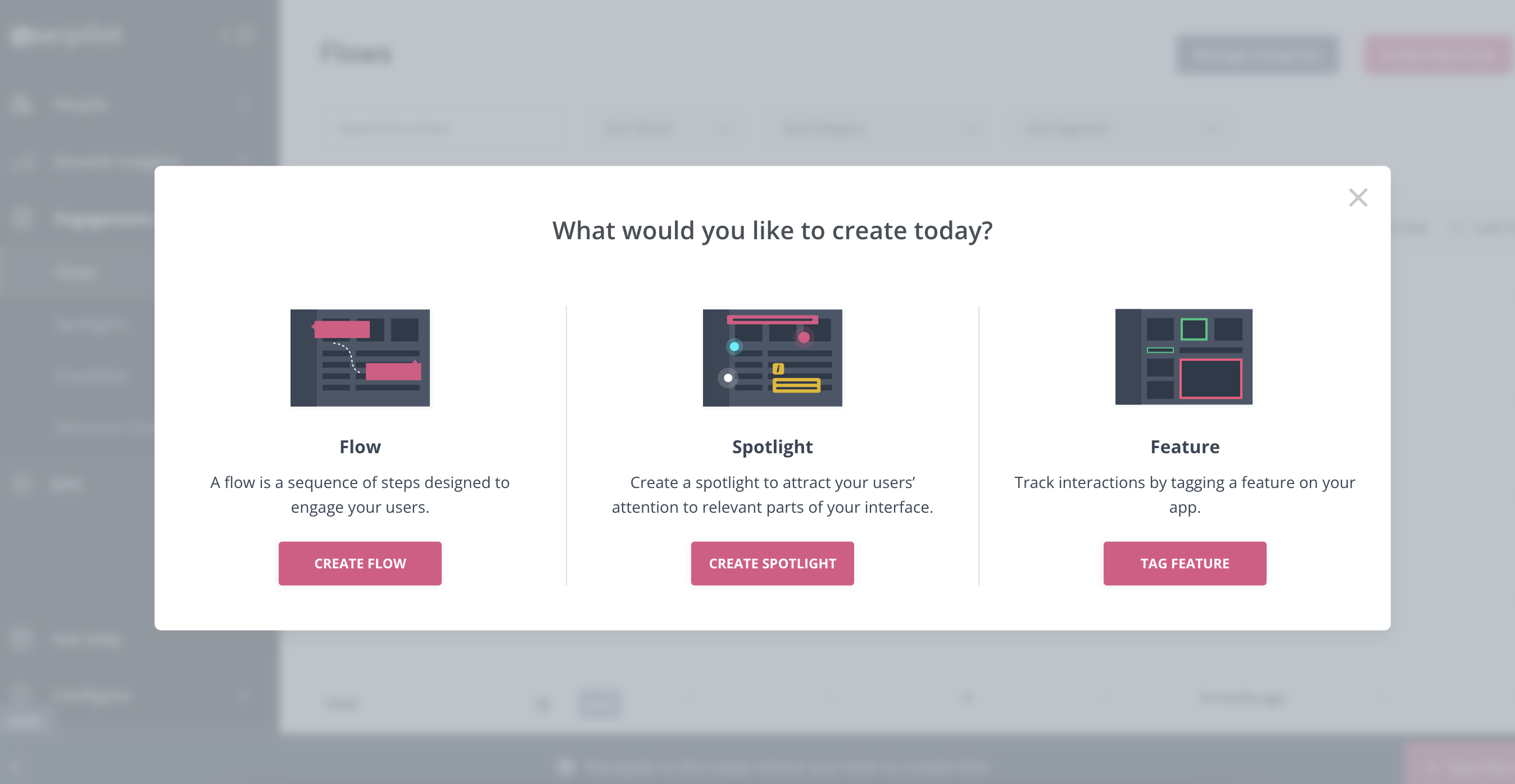
Userpilot for product adoption.
Here are some of Userpilot’s product adoption features that you may find helpful:
- A broad range of UI patterns to build fully customizable, contextual, and interactive in-app flows: modals, slideouts, tooltips, hotspots, driven actions, banners, and more. And – most importantly – you are not limited by plan when it comes to how many UI patterns or designs you can build.
- Advanced in-app checklists with built-in gamification elements like progress bars or ”automatically marked complete” tasks: checklists also come with analytics so you can track who is interacting with them and how.
- Fully interactive walkthroughs walk users through engaging and adopting specific features of your app.
- The self-service in-app resource center lets users search your knowledge base directly inside the app, access chat, and support but also launch guides and tutorials when they get stuck.
- User feedback tools allow you to collect insights to improve the product and the user experience, thus leading to a higher product adoption rate. You can also collect NPS data and tag responses to uncover patterns into what makes users stick, or build micro surveys for more granular data. Then you can use all the feedback collected to build user segments based on the answers and personalize the path to higher product adoption for each segment.
Want to see Userpilot in action? Get a demo and improve product adoption with contextual and personalized in-app flows that actually help users.
Userpilot for user feedback
There are two types of feedback you should be focusing on collecting to better understand the health of your product and users.
First, you have user sentiment which looks at user satisfaction and effort scores or loyalty (using NPS surveys). Then you may also want to collect feedback on the functionality of the product or specific features.
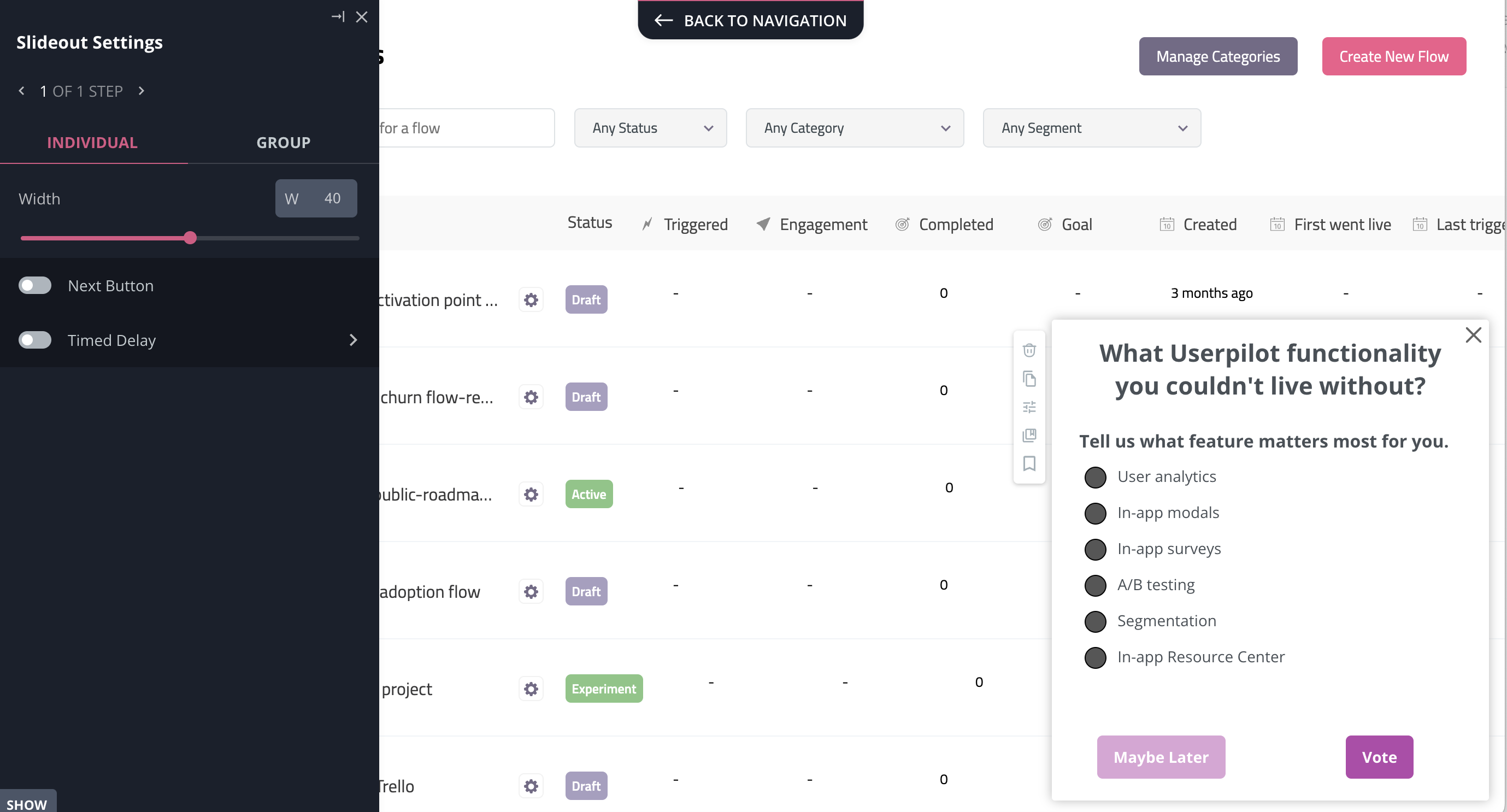
Userpilot for user feedback.
You can do all these with Userpilot. In short, you can:
- Collect and track (NPS) in-app with a built-in NPS widget that allows you to fully customize the survey look and feel, and set the trigger frequency and specific targeting.
- Analyze NPS scores, tag responses, and use the data to create specific user segments.
- Build and trigger in-app micro surveys like the classic PMF survey, or similar ones and mix multi-choice and open-ended types of questions to collect specific insights.
- Be in charge of who gets which survey type and when with advanced segmentation capabilities, and of course, you can use the answers to segment your audience.
The advantage of using Userpilot for collecting feedback over other survey tools is that you can better control who sees the surveys but also you can instantly use the data collected to segment your user base and trigger the right experience for them.
For instance, if your users give you a low NPS score because they think you’re missing a critical feature (that you actually have already), you can push an interactive walkthrough guiding them to find and explore this feature.
![]()
Tired of bad digital adoption tools? Try Userpilot for your SaaS!

So Which tool should you choose – Appcues, Usetiful or Userpilot?
As you can see, Appcues, Usetiful, and Userpilot cater to most of the use cases Product Managers typically look for in their SaaS companies. There are some differences between the tools when it comes to how those use cases are executed in each, of course. So if you’re still on the fence – there are two more factors that can make a difference for you – the tools’ pricing, and its reviews. Let’s have a look at both below!
Appcues pricing
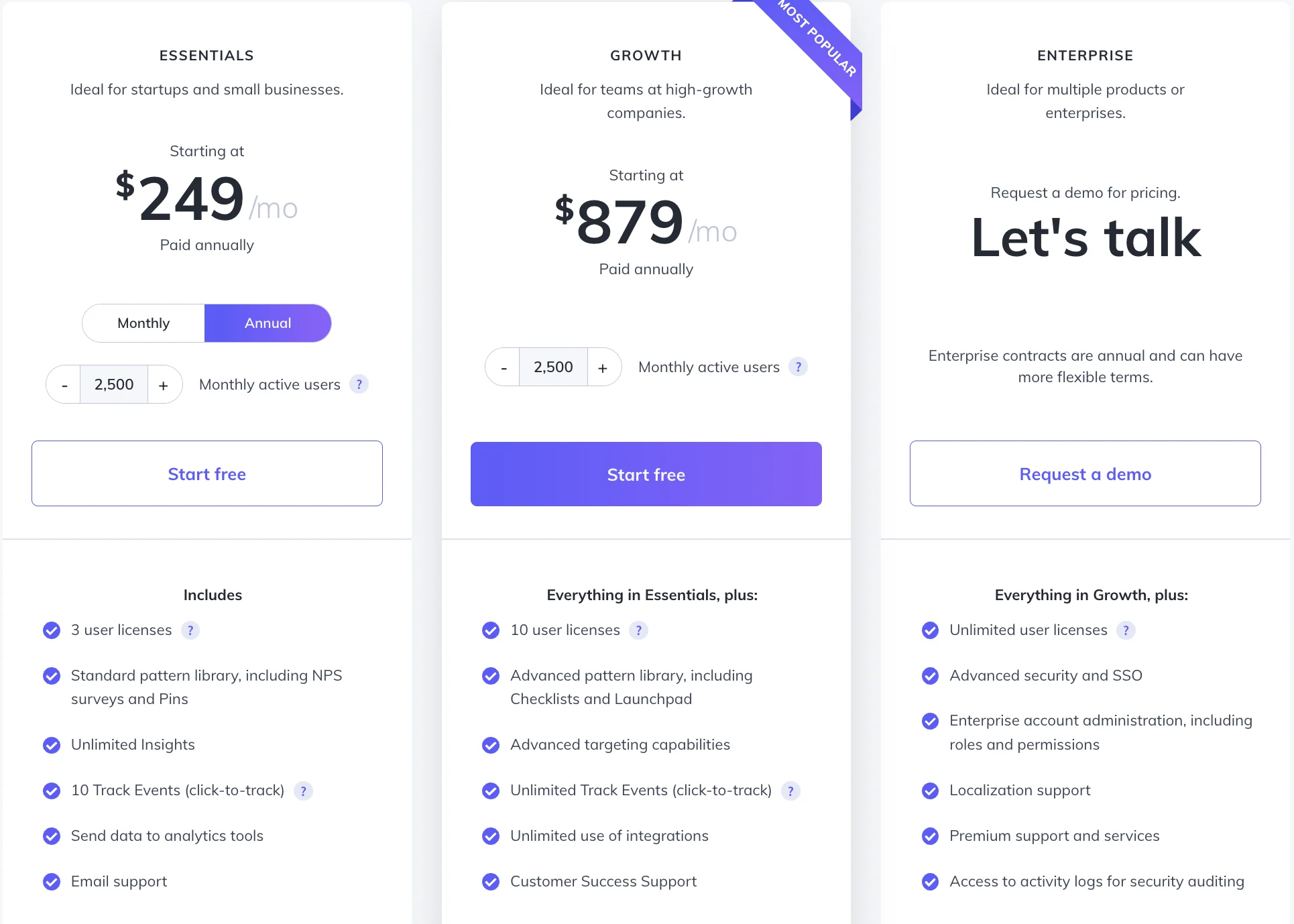
Appcues pricing.
All things considered, Appcues does not offer the best value for money compared to some Appcues alternatives – at $249 per month. If your product has 2,500 active users, the costs for different plans are:
- Essentials: $249/month (Up to 3 user licenses)
- Growth: $879/month (Up to 10 user licenses)
- Enterprise: Custom (Unlimited user licenses)
Usetiful pricing
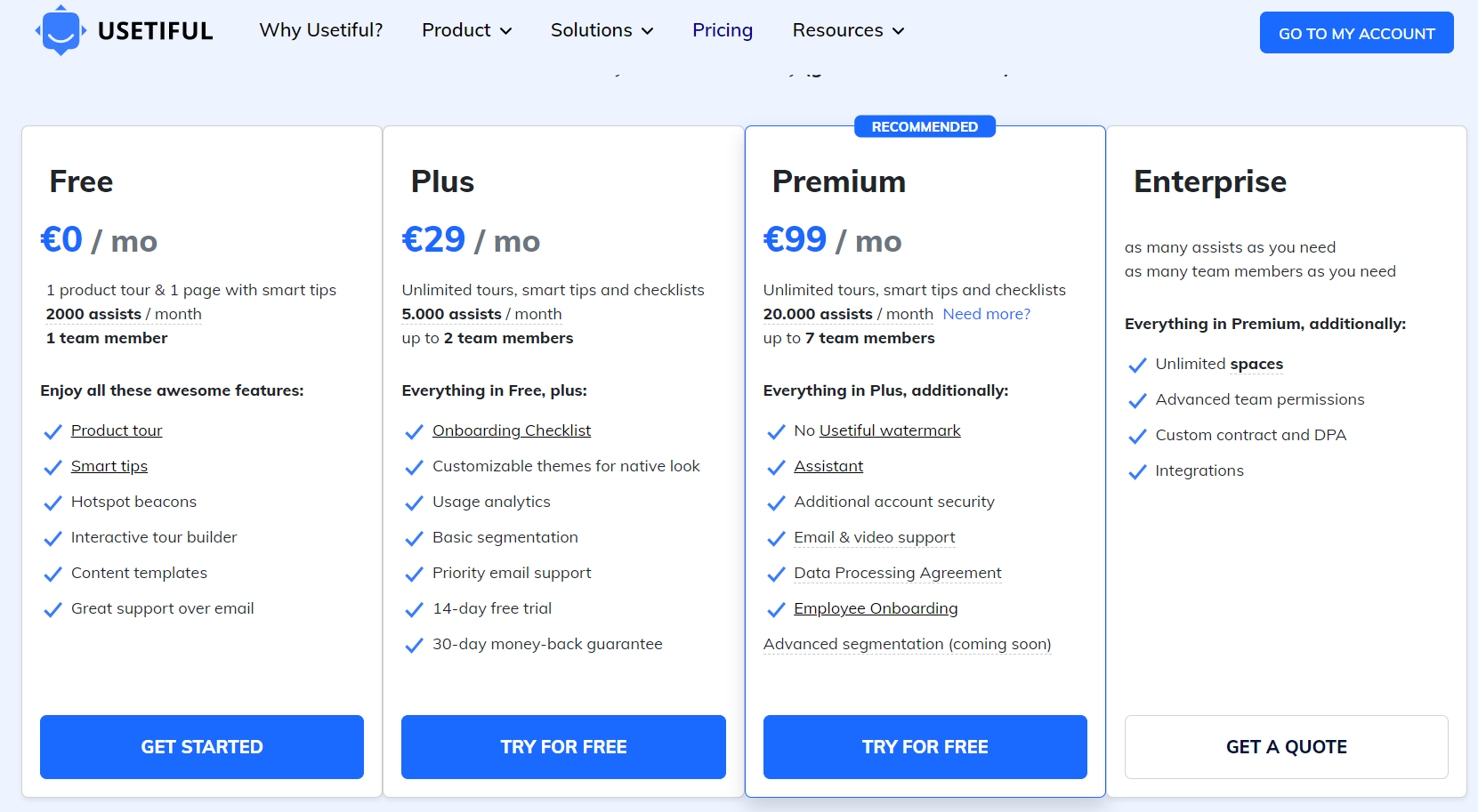
Usetiful pricing.
Usertiful offers straightforward pricing plans. There are four tiers, each charging a set amount for access to certain features.
- Free: allows you to create one product tour and multiple smart tips across 1 URL.
- Plus – €29/month: includes unlimited product tours, smart tips, and checklists, access to usage analytics, and basic segmentation features.
- Premium – €99/month: create designs without the Usetiful watermark, build more sophisticated segments, and access tools for employee onboarding.
- Enterprise: everything in Premium Plus run Usetiful on multiple products and environments.
Userpilot pricing
Userpilot’s transparent pricing ranges from $249/month on the entry-level end to an Enterprise tier for larger companies.
Furthermore, Userpilot’s entry-level plan includes access to all UI patterns and should include everything that most mid-market SaaS businesses need to get started.

Userpilot has three paid plans to choose from:
- Starter: The entry-level Starter plan starts at $249/month and includes features like segmentation, product analytics, reporting, user engagement, NPS feedback, and customization.
- Growth: The Growth plan starts at $749/month and includes features like resource centers, advanced event-based triggers, unlimited feature tagging, AI-powered content localization, EU hosting options, and a dedicated customer success manager.
- Enterprise: The Enterprise plan uses custom pricing and includes all the features from Starter + Growth plus custom roles/permissions, access to premium integrations, priority support, custom contract, SLA, SAML SSO, activity logs, security audit, and compliance (SOC 2/GDPR).
What do users say about Appcues, Usetiful & Userpilot?
By exploring the experiences of others who have used these platforms, you can gain a better understanding of their strengths and weaknesses and make an informed decision about which one best suits your needs. So, let’s dig into some customer reviews.
Appcues reviews
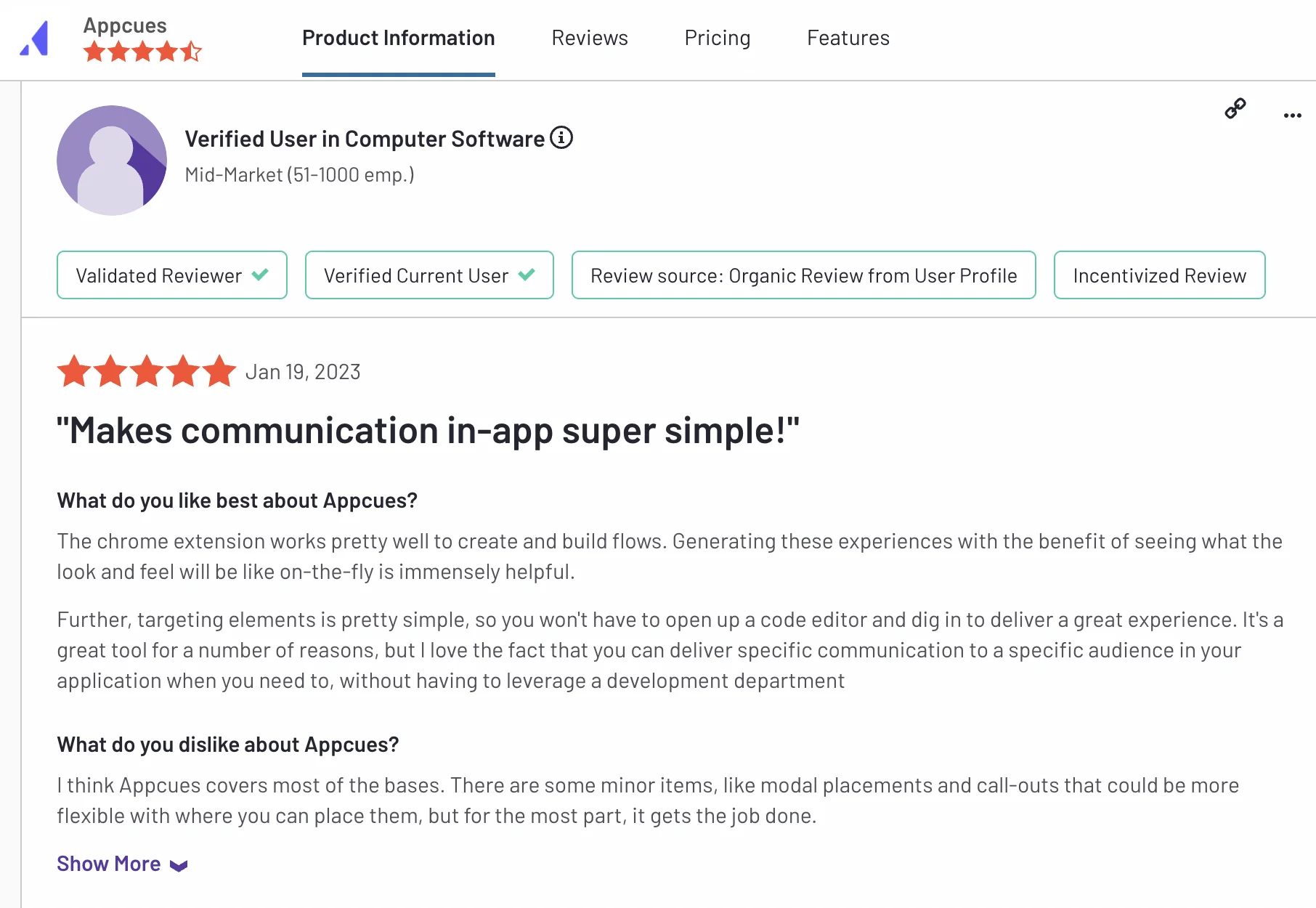
Appcues review.
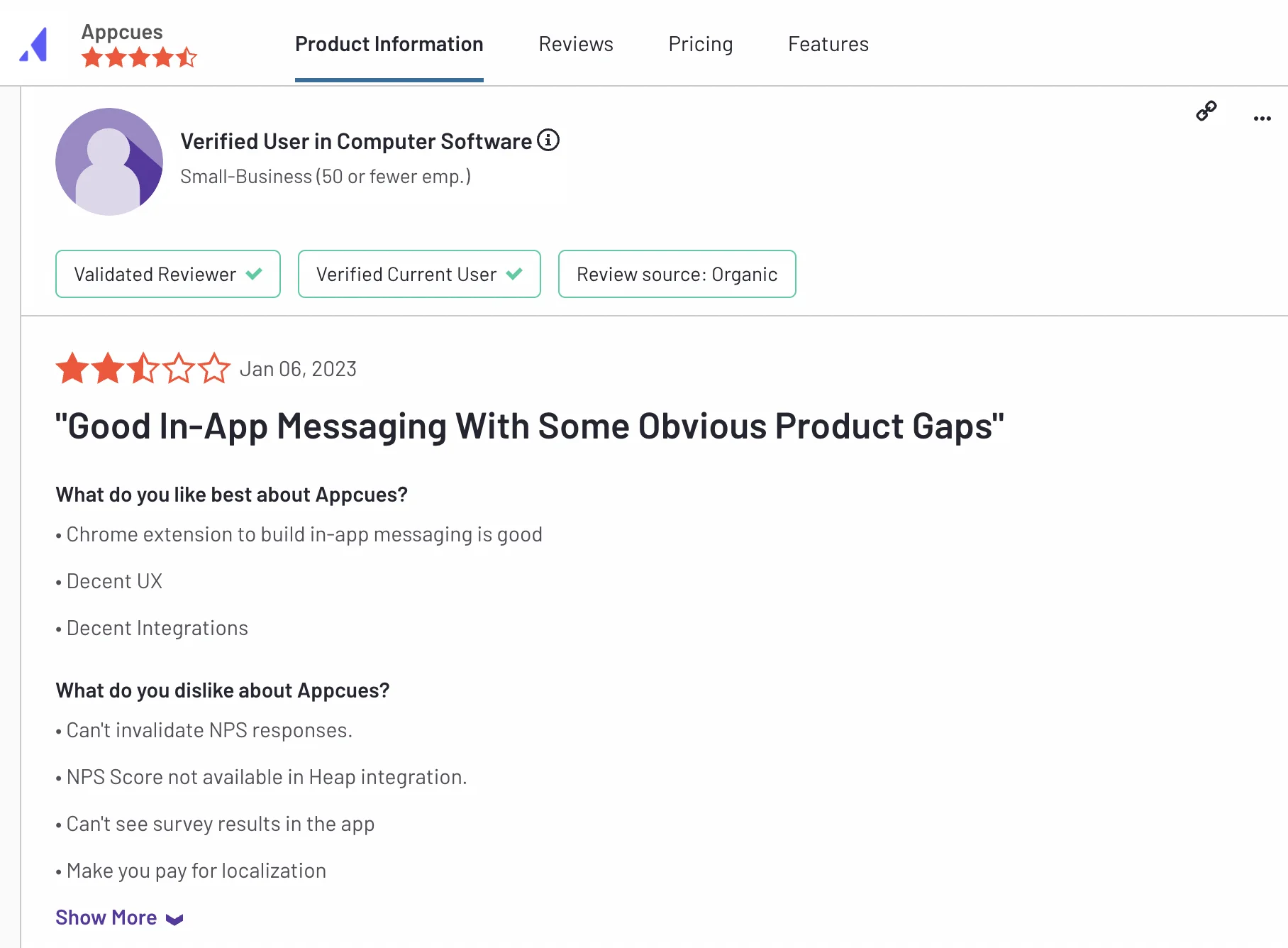
Appcues review.
Usetiful reviews
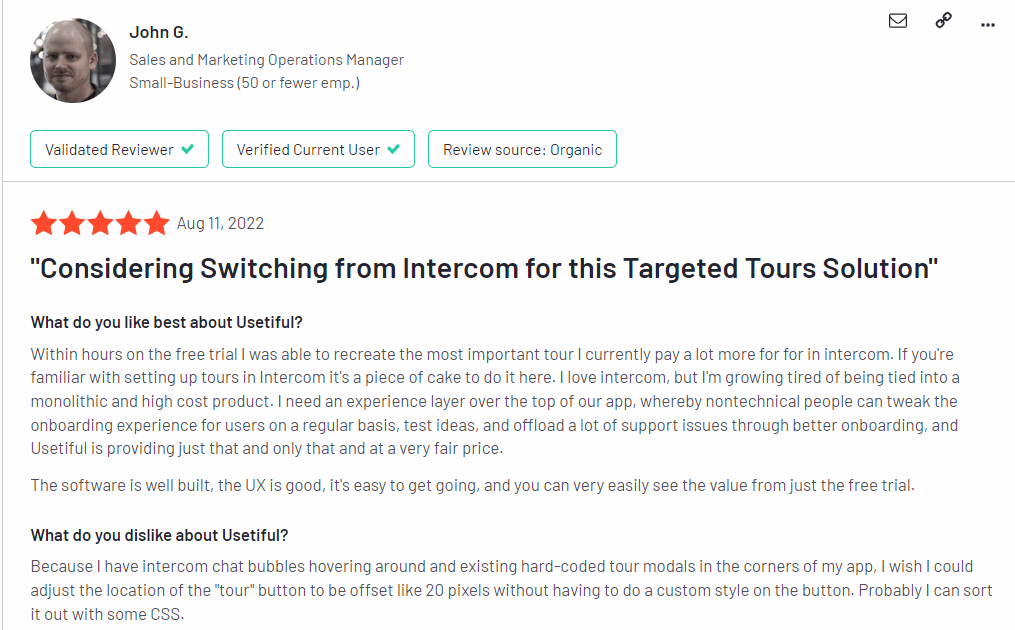
Usetiful review.
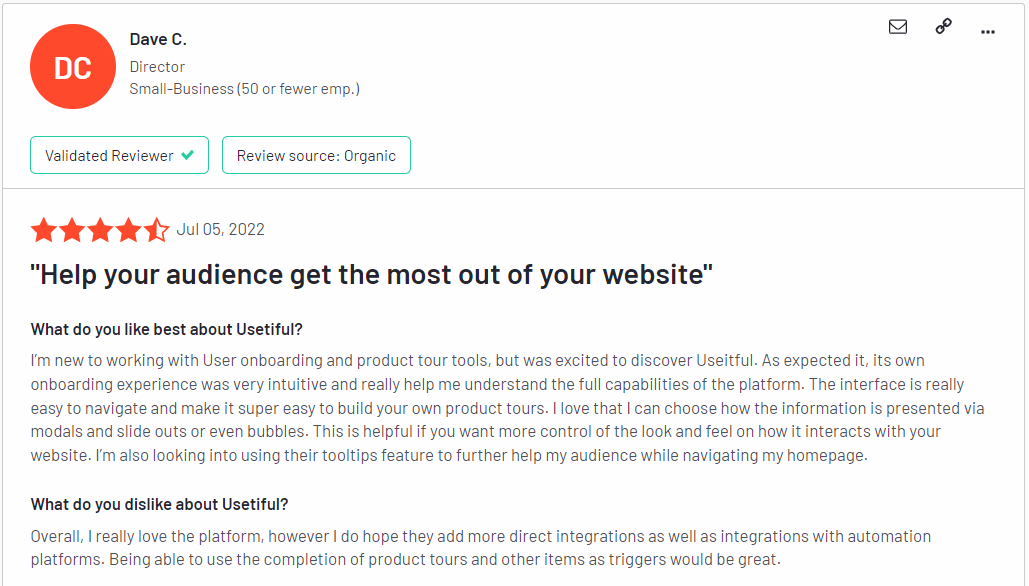
Usetiful review.
Userpilot reviews

Userpilot review.
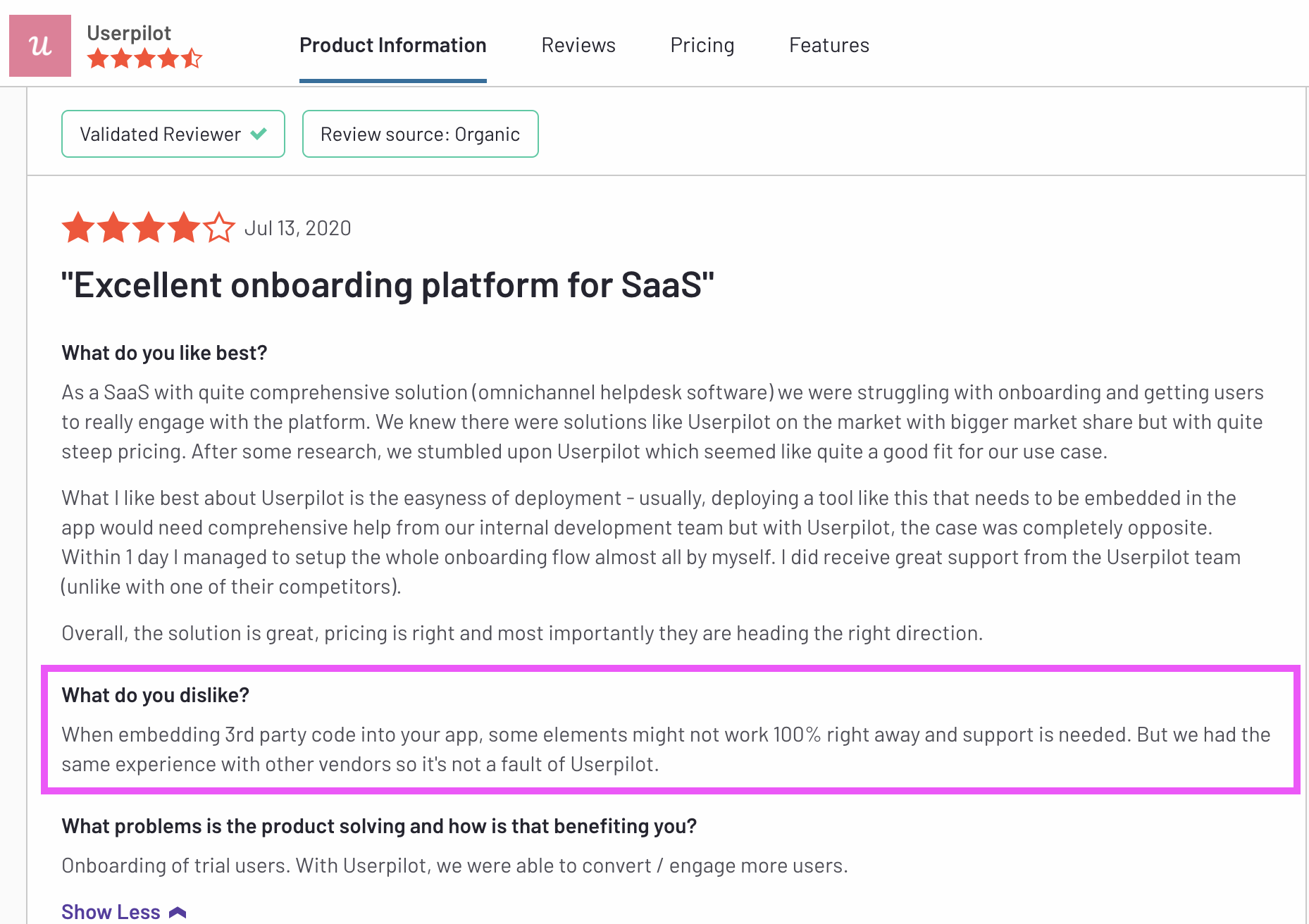
Userpilot review.
Pros & Cons of Appcues, Usetiful & Userpilot
In this section, we will provide a comprehensive list of the advantages and disadvantages of using Appcues, Usetiful, and Userpilot. By understanding the pros and cons of each platform, you can make an informed decision about which one will best meet your specific needs and goals.
Appcues pros
Let’s look at some key advantages of Appcues:
- It makes it easy to build product tours with a user-friendly UI and predefined templates that can save you time.
- Can be used on web apps and mobile apps too.
- It integrates with most user analytics tools: Heap, Segment, Amplitude, and Mixpanel. This compensates a bit for the lack of in-depth analytics but means you need multiple subscriptions.
- You can use predefined flows or build your own using a good range of UI patterns.
- Allows basic segmentation and event-based flow triggering.
- It’s easy to build in-app surveys using modals or the integrated NPS tool.
Appcues cons
But as any tool, Appcues is not without its flaws – and at this price point, we think you may really want to consider some options that offer the same or more advanced functionality, but at a lower price tag:
- Appcues lacks certain transition actions like driven actions, scroll position, or page change, which would make product tours more interactive.
- It heavily limits the functionality available in the lowest (Essentials) plan. If you need checklists, more than 10 events, or more than 5 user segments, you’ll need to upgrade to the Growth plan (starting at $879/mo payable annually, which means you need to fork out more than $10,500 to start using Appcues for more use cases.
- Appcues doesn’t have a resource center feature, meaning you can’t use it to offer self-service support to your users.
Usetiful pros
Usetiful is an effective tool for streamlining your onboarding and adoption processes. If you are still weighing your options, here are some benefits to consider:
- The software works with your own and third-party tools alike, meaning it can be used for both customer and employee onboarding.
- Usetiful comes with an easy-to-use Chrome Extension builder that sits on top of your app and enables even non-technical team members to design functional onboarding flows within minutes.
- With Usetiful, you can leverage segmentation to deliver personalized onboarding experiences for your customers.
- Free plan and affordable pricing make it an excellent choice for small businesses and startups.
Usetiful cons
Usetiful, like any other app, has its own downsides and flaws. Here are the main cons of Usetiful:
- Since it’s a relatively new tool, you’ll encounter some bugs and performance issues when using it.
- Customization options are limited with colors and fonts. This can be frustrating for established companies that want to have complete control over the look and feel of onboarding UX patterns.
- Web apps only – Usetiful doesn’t work on mobile devices/applications.
- You can’t launch a self-service resource center where users can access multiple types of guides and tutorials.
- Usetiful has almost no built-in integrations with other tools, although it does have webhooks.
Userpilot pros
Userpilot has a number of advantages, especially for mid-market SaaS companies looking for a robust but at the same time very easy-to-use, no-code tool for user onboarding, product adoption, and simplified product analytics. Let’s have a look at the pros of using Userpilot:
- No-code builder – Userpilot comes with an easy-to-use Chrome Extension builder.
- Multiple UI patterns – choose from a range of options to build customized flows: modals, slideouts, banners, tooltips, hotspots, and checklists are all at your disposal
- UI patterns are not limited by plan – you get access to all of them on every single plan, meaning you get value even with the Traction plan (this is the entry-level one).
- Engaging walkthroughs and onboarding flows- build interactive walkthroughs targeted to distinct user segments.
- In-app help – build a resource center offering self-service support to your users, customize it with your branding, and select from a range of help options to boost user satisfaction (i.e. videos, in-app flows, chat, and more).
- Experimentation – built-in A/B testing for flows lets you explore and quickly iterate based on direct user behavior.
- Powerful feedback options- integrated NPS surveys with analytics and response tagging unlock insight into how your users feel.
- Advanced analytics and segmentation- analyze product usage and in-app flow engagement and build user segments using the data.
- Event tracking and feature tags- tag UI engagement (clicks, form fills, hovers) and group them into one custom event to track what really matters.
- More value with integrations- unlock value faster with built-in integrations with popular tools like Segment, Amplitude, Mixpanel, Kissmetrics, Intercom, Heap, and more.
Userpilot cons
There are, however, some downsides to Userpilot as well:
- Browser/web app only – Userpilot won’t run on mobile devices/applications.
- Doesn’t support employee onboarding- The tool is better suited for customer onboarding than for employee onboarding as you can’t build in-app guides on third-party tools.
- Missing integrations – doesn’t have built-in integrations with some tools, but it has webhooks, and Hubspot and Zapier are coming soon.
- Not appropriate for small startups on a shoestring budget (<$100)- Userpilot is a powerful, mid-market to enterprise-level tool. So $249 a month might be too expensive for really small startups.
![]()
Try the best tool for user onboarding!

Conclusion
Within this article, we have explored and compared the user onboarding, product adoption, and user feedback features of Appcues, Usetiful, and Userpilot. We have provided an analysis of their respective functionalities, pricing, and customer feedback, as well as the advantages and disadvantages of each platform. We trust that our in-depth explanations have proven to be informative.
Although our viewpoint may be biased, we believe that Userpilot provides the most advantageous value for money, especially in terms of user onboarding.
If you are interested, we encourage you to book a Userpilot demo. We look forward to seeing you there!

